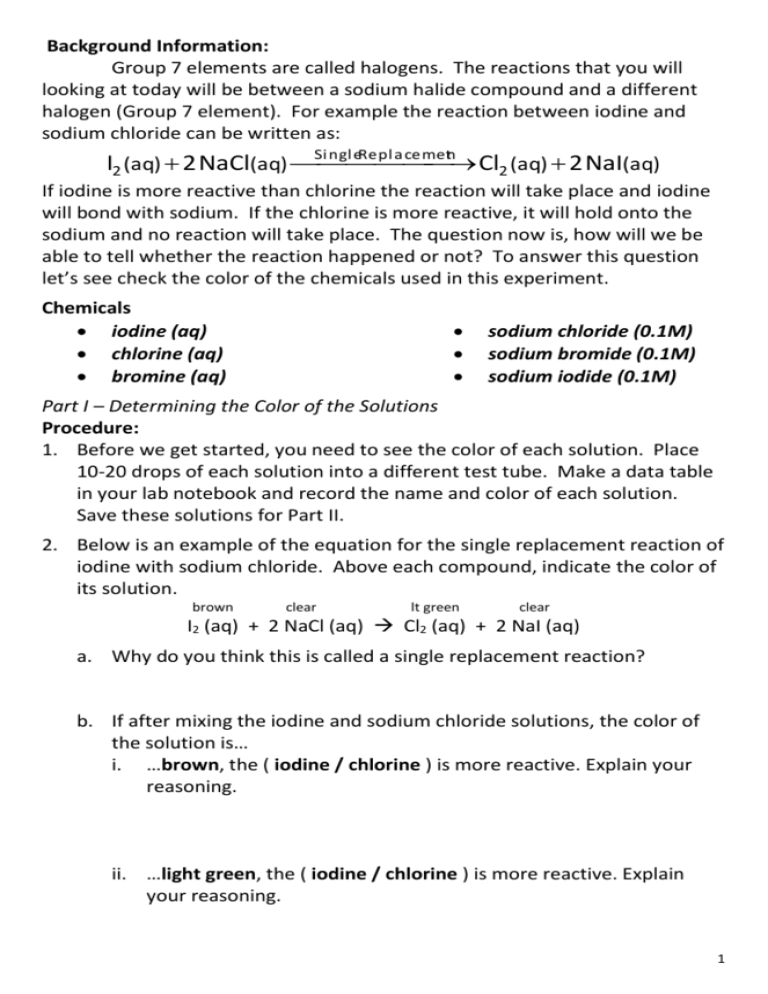Reactivity of Halides
advertisement

Background Information: Group 7 elements are called halogens. The reactions that you will looking at today will be between a sodium halide compound and a different halogen (Group 7 element). For example the reaction between iodine and sodium chloride can be written as: ngl eRepl a cemen I2 (aq) 2 NaCl(aq) Si t Cl2 (aq) 2 NaI(aq) If iodine is more reactive than chlorine the reaction will take place and iodine will bond with sodium. If the chlorine is more reactive, it will hold onto the sodium and no reaction will take place. The question now is, how will we be able to tell whether the reaction happened or not? To answer this question let’s see check the color of the chemicals used in this experiment. Chemicals iodine (aq) chlorine (aq) bromine (aq) sodium chloride (0.1M) sodium bromide (0.1M) sodium iodide (0.1M) Part I – Determining the Color of the Solutions Procedure: 1. Before we get started, you need to see the color of each solution. Place 10-20 drops of each solution into a different test tube. Make a data table in your lab notebook and record the name and color of each solution. Save these solutions for Part II. 2. Below is an example of the equation for the single replacement reaction of iodine with sodium chloride. Above each compound, indicate the color of its solution. brown clear lt green clear I2 (aq) + 2 NaCl (aq) Cl2 (aq) + 2 NaI (aq) a. Why do you think this is called a single replacement reaction? b. If after mixing the iodine and sodium chloride solutions, the color of the solution is… i. …brown, the ( iodine / chlorine ) is more reactive. Explain your reasoning. ii. …light green, the ( iodine / chlorine ) is more reactive. Explain your reasoning. 1 4. Write the equation for the single replacement reaction of iodine with sodium bromide. Above each compound, indicate its color. a. If iodine is more reactive than bromine, what color would you expect to see after the reaction? Explain your reasoning. b. If bromine is more reactive than iodine, what color would you expect to see after the reaction? Explain your reasoning. Part II – Determining the Reactivity of Halogens Procedure: 1. Design a procedure to test which halide is the most and least reactive. a. Be sure to include enough detail in your procedure so that I can “see” exactly what you did. Also be sure to include a data table to record your observations. 2. I want to talk to your group about your procedure before you get started. 3. Guidelines: a. Use about 10-20 drops of each solution. Once you see evidence of a change, you do not have to continue adding more solution. b. Make a data table to collect observations for each reaction. 2 Post Lab Questions: 1. Rank the bromine, chlorine, and iodine from most to least reactive? a. Support your ranking above with evidence from the lab. 2. Find bromine, chlorine, and iodine on the periodic table. Do the nonmetals seem to get more reactive or less reactive as you move down a group? a. Is this pattern the same as the reactivity trend for metals? 3. From the pattern in your data, would you expect astatine to more or less reactive than chlorine? Explain your reasoning. 4. Using your observations from the lab, which non-metal should be most reactive? 5. How does the trend in reactivity of non-metals compare to the trend in reactivity for metals. 3 6. From the Coulombic Attractions POGIL you learned that atoms tend to get bigger as you move down the periodic table. Fill in the table below. Element Moving Down the Periodic Table Relative Relative Strength of atomic size hold on valence e- Reactivity Cl2 Br2 I2 a. Considering your answers in the table above, non-metals tend to ( lose / gain ) electrons during a chemical reaction. Explain your reasoning in terms of strength of attraction and reactivity. 7. From the Coulombic Attractions POGIL you learned that atoms tend to get smaller as you move from left to right across the periodic table. Fill in the table below. You will have to predict whether P is more or less reactive than chlorine based on your answer from 8b and your understanding or atomic size and the strength of electron attraction. Moving Left or Right Across the Periodic Table Relative Relative Strength of Element Reactivity atomic size hold on valence eP Cl a. Explain how you used atomic size, the strength of electron attraction, and the tendency of non-metals to gain electrons to determine that P is less reactive than Cl. 8. We concluded in the Reactivity of Group II Metals lab that metals must be losing electrons since the most reactive metals are the ones with the weakest hold on electrons. With this in mind, why do you think the reactivity trend for non-metals is opposite that of metals. 4








